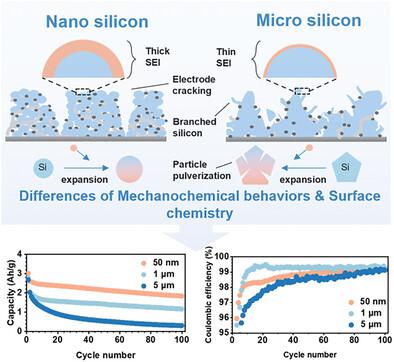Our official English website, www.x-mol.net, welcomes your
feedback! (Note: you will need to create a separate account there.)
Benchmarking the Effect of Particle Size on Silicon Anode Materials for Lithium-Ion Batteries
Small ( IF 13.0 ) Pub Date : 2023-06-20 , DOI: 10.1002/smll.202301301 Feng Wu 1, 2 , Yu Dong 1 , Yuefeng Su 1, 2 , Chenxi Wei 3 , Tongren Chen 1 , Wengang Yan 1 , Siyuan Ma 1, 2 , Liang Ma 1, 2 , Bin Wang 4 , Lai Chen 1, 2 , Qing Huang 1, 2 , Duanyun Cao 1, 2 , Yun Lu 1, 2 , Meng Wang 2 , Lian Wang 2 , Guoqiang Tan 1, 2 , Jionghui Wang 4 , Ning Li 1, 2
Small ( IF 13.0 ) Pub Date : 2023-06-20 , DOI: 10.1002/smll.202301301 Feng Wu 1, 2 , Yu Dong 1 , Yuefeng Su 1, 2 , Chenxi Wei 3 , Tongren Chen 1 , Wengang Yan 1 , Siyuan Ma 1, 2 , Liang Ma 1, 2 , Bin Wang 4 , Lai Chen 1, 2 , Qing Huang 1, 2 , Duanyun Cao 1, 2 , Yun Lu 1, 2 , Meng Wang 2 , Lian Wang 2 , Guoqiang Tan 1, 2 , Jionghui Wang 4 , Ning Li 1, 2
Affiliation

|
High-capacity silicon has been regarded as one of the most promising anodes for high-energy lithium-ion batteries. However, it suffers from severe volume expansion, particle pulverization, and repeated solid electrolyte interphase (SEI) growth, which leads to rapid electrochemical failure, while the particle size also plays key role here and its effects remain elusive. In this paper, through multiple-physical, chemical, and synchrotron-based characterizations, the evolutions of the composition, structure, morphology, and surface chemistry of silicon anodes with the particle size ranging from 50 to 5 µm upon cycling are benchmarked, which greatly link to their electrochemical failure discrepancies. It is found that the nano- and micro-silicon anodes undergo similar crystal to amorphous phase transition, but quite different composition transition upon de-/lithiation; at the same time, the nano- and 1 µm-silicon samples present obviously different mechanochemical behaviors from the 5 µm-silicon sample, such as electrode crack, particle pulverization/crack as well as volume expansion; in addition, the micro-silicon samples possess much thinner SEI layer than the nano-silicon samples upon cycling, and also differences in SEI compositions. It is hoped this comprehensive study and understanding should offer critical insights into the exclusive and customized modification strategies to diverse silicon anodes ranging from nano to microscale.
中文翻译:

粒度对锂离子电池硅负极材料影响的基准测试
高容量硅被认为是高能锂离子电池最有前途的负极之一。然而,它会遭受严重的体积膨胀、颗粒粉碎和反复的固体电解质界面(SEI)生长,从而导致快速电化学失效,而颗粒尺寸在这里也起着关键作用,其影响仍然难以捉摸。本文通过多种物理、化学和基于同步加速器的表征,对粒径范围为 50 至 5 µm 的硅负极在循环过程中的成分、结构、形貌和表面化学的演变进行了基准测试,这极大地提高了硅负极的性能。与其电化学故障差异有关。研究发现,纳米硅阳极和微米硅阳极经历了类似的晶体到非晶相变,但脱锂/锂化时的成分转变却截然不同;同时,纳米和1μm硅样品呈现出与5μm硅样品明显不同的力学化学行为,如电极裂纹、颗粒粉碎/裂纹以及体积膨胀;此外,在循环过程中,微米硅样品比纳米硅样品具有更薄的SEI层,并且SEI成分也存在差异。希望这种全面的研究和理解能够为从纳米到微米尺度的各种硅阳极的独特和定制的改性策略提供重要的见解。
更新日期:2023-06-20
中文翻译:

粒度对锂离子电池硅负极材料影响的基准测试
高容量硅被认为是高能锂离子电池最有前途的负极之一。然而,它会遭受严重的体积膨胀、颗粒粉碎和反复的固体电解质界面(SEI)生长,从而导致快速电化学失效,而颗粒尺寸在这里也起着关键作用,其影响仍然难以捉摸。本文通过多种物理、化学和基于同步加速器的表征,对粒径范围为 50 至 5 µm 的硅负极在循环过程中的成分、结构、形貌和表面化学的演变进行了基准测试,这极大地提高了硅负极的性能。与其电化学故障差异有关。研究发现,纳米硅阳极和微米硅阳极经历了类似的晶体到非晶相变,但脱锂/锂化时的成分转变却截然不同;同时,纳米和1μm硅样品呈现出与5μm硅样品明显不同的力学化学行为,如电极裂纹、颗粒粉碎/裂纹以及体积膨胀;此外,在循环过程中,微米硅样品比纳米硅样品具有更薄的SEI层,并且SEI成分也存在差异。希望这种全面的研究和理解能够为从纳米到微米尺度的各种硅阳极的独特和定制的改性策略提供重要的见解。


















































 京公网安备 11010802027423号
京公网安备 11010802027423号